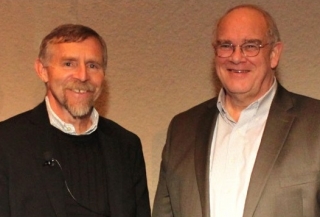BY DUSTIN HAYS
Dr. Dennis Clegg recently visited NIH and gave a summary of his efforts with the California Project to Cure Blindness to develop a stem cell-based therapy for age-related macular degeneration (AMD), a major cause of blindness in the U.S. His talk was the second installment in the National Eye Institute Audacious Goals Initiative Seminar Series in Neuroregeneration.
“We hope this will be the next pillar of medicine—using cells to treat disease,” said Clegg, a professor at the University of California, Santa Barbara, department of molecular, cellular and developmental biology.
The eye is the ideal organ for pursing stem cell therapies, said Clegg. Existing imaging and surgical techniques make the eye more accessible than other organs. Measuring the eye’s function is straightforward. And a relatively small number of cells are needed to treat eye disorders.
The project is using stem cells to make replacement retinal pigment epithelium (RPE), the layer of tissue in the back of the eye that supports the function of rod and cone photoreceptors. The photoreceptors react to light, launching nerve signals that cascade through the retina before converging at the optic nerve and dispersing throughout the brain.
AMD attacks the RPE, causing dysfunction of the photoreceptors. Without a healthy RPE, the photoreceptors eventually die, resulting in vision loss. The project recently gained FDA approval to begin implanting tiny sheets of stem cell-derived RPE into AMD patients’ retinas. The hope is that the healthy RPE implant will rescue surviving photoreceptors, thus preserving vision.
Clegg addressed challenges in launching the clinical trial.
First was selecting the best approach to making RPE cells. Clegg’s group chose to start with human embryonic stem cell lines and then learned how to efficiently convert them into highly pure, authentic RPE cells. Their process— from stem cells to mature RPE cells—takes about 6 months. The cells are then frozen until needed.
The second challenge was devising a method to deliver the cells to the appropriate place in the retina. The RPE cells are seeded onto biostable scaffolds, encouraging correct orientation of the cells (RPE cells have a top and a bottom). The team designed retractable forceps that roll the implant—about the size of the Lincoln Memorial on the back of a penny—into a taco shape and pulls it into a hollow needle. The surgeon then temporarily detaches the retina and injects the RPE “taco” into the appropriate spot where it unfurls, flattening out as the retina re-attaches.
Design of the scaffold also addressed the third major challenge: keeping the cells alive. “Putting healthy cells on a diseased retina may be like putting cells on Mars,” said Clegg. So the scientists built the scaffold to mimic Bruch’s membrane, the tissue next to the RPE, using an ultrathin polymer called parylene coated with the protein vitronectin. According to Clegg, the design enhances the diffusion of nutrients across the RPE.
When it comes time to treat patients, frozen RPE cells will be thawed, cultured on the scaffold and shipped to the point of care—a process that takes 30 days.
With major funding from the California Institute for Regenerative Medicine, the project includes collaborators from UCSB, University of Southern California, University College London, Caltech and the City of Hope. Clegg’s startup company, Regenerative Patch Technologies, is sponsoring the clinical trial.
Clegg’s project is just one in a competitive field of about 10 research groups attempting to regenerate RPE, starting from a variety of cell sources.
In 2011, researchers led by Robert Lanza became the first to inject stem cell-derived RPE cells into an AMD patient. More recently, the London Project to Cure Blindness has implanted two patients with RPE derived from embryonic stem cells on a polyester scaffold to treat the wet form of AMD.
In 2014, Japanese researchers led by Masayo Takahashi became the first to treat the wet form of AMD—a severe type of AMD that afflicts retinal blood vessels—by implanting scaffold-less sheets of RPE derived from induced pluripotent stem (iPS) cells. Such cells are made by reprogramming adult cells to a naive state. Stadtman Investigator Kapil Bharti and colleagues in the NEI intramural research program are using iPS cell-derived RPE cells seeded onto scaffolds. Other groups are starting with umbilical cord stem cells or adult stem cells.
“The field reminds me of the current presidential campaign,” said Clegg. “There are a lot of different approaches. We don’t know which one will succeed eventually, but it’s worth it to go out and try.”

